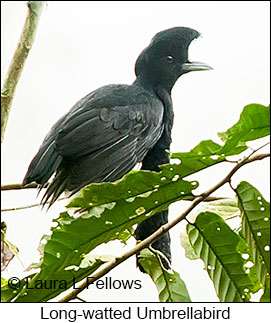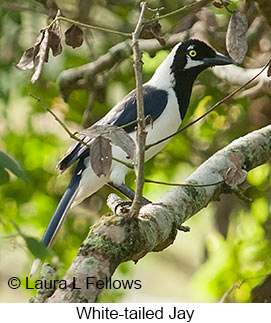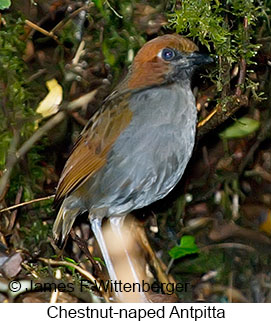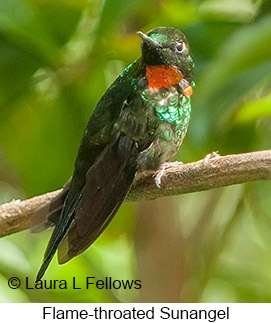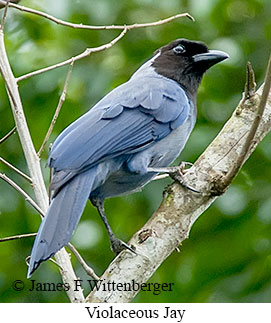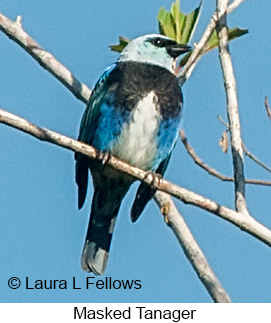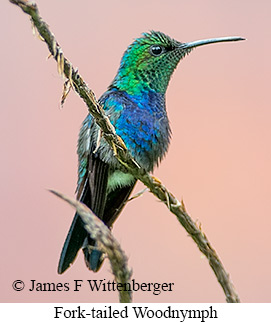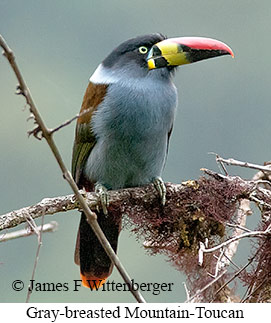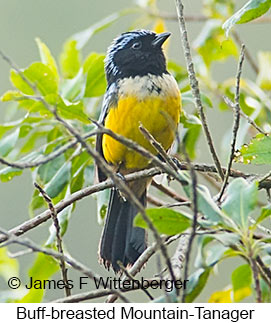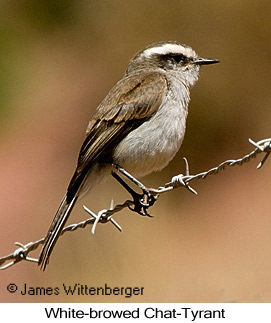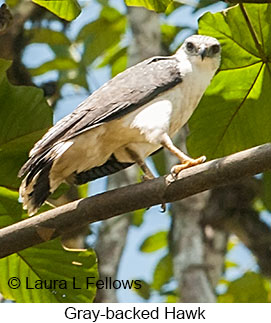SOUTHERN ECUADOR BIRDING TOUR
Tour Description

ECUADOR
BIRDING TOUR
ANY TIME*
| Duration: | 20 days, 19 nights |
| Group Size: | 2-6 |
| Anytime Price: | $7850 |
| Group Price: | $7300 |
| Single Suppl: | $600 |
| Est #Species: | 475-525 |
| Pace: | Easy/Moderate |
| Difficulty: | Easy/Moderate |
| * This tour is available for any dates of your choosing provided guide services and accommodations are available. | |
DAY 1 - GUAYAQUIL
International flights arrive by evening. You will be met by guide at the airport. Night at Hotel Palace Guayaquil.
DAY 2 - MANGLARES-CHURUTE & TRANSFER
Early departure for Buenaventura Reserve, stopping in Manglares-Churute for morning birding. Habitat is mainly lowland deciduous forest and scrub. Main target species is Pacific Royal-Flycatcher. Other possibilities include Ecuadorian Ground Dove, Gray-cheeked Parakeet, Red-billed Scythebill, and Ecuadorian Thrush.
Stops en route will offer various widely distributed wetland species including shorebirds, herons, bulls, and terns along with some woodland species in forest patches such as Black-cheeked Woodpecker, Red-rumped Woodpecker, Jet Antbird, Sooty-headed Tyrannulet, Black-tailed Flycatcher, Rusty-margined Flycatcher, Lemon-rumped Tanager, and Yellow-bellied Seedeater. Night at Umbrellabird Lodge in Buenaventura Reserve.
DAYS 3-4 - BUENAVENTURA RESERVE
One full day will be spent birding the lower section of Buenaventura and one day the upper section. The upper section can be foggy so the day spent there will depend on conditions. Key target species are Long-wattled Umbrellabird in the lower forested area and the endemic El Oro Parakeet in more open habitat at higher elevation. The umbrellabirds display on leks within the forest, where they show off their ulta-long wattles, while the parakeets usually appear flying overhead in flocks but sometimes perch in the tops of trees. Many other species are present in the reserve. The difficult Esmeraldas Antbird and Ochre-breasted Antpitta are possible. Also possible are some elusive species such as Pallid Dove, White-tipped Sicklebille, Uniform Treehunter, El Oro Tapaculo, Ochraceous Attila, Club-winged Manakin, and Scaled Fruiteater. Other notable species include Gray-backed Hawk, Gray Hawk, Bronze-winged Parrot, Collared Trogon, Crimson-rumped Toucanet, Pale-billed Aracari, Choco Tourcan, Guayaquil Woodpecker, Scaly-throated Foliage-gleaner, Brown-billed Scythebill, Uniform Antshrike, Russet Antshrike, Checker-throated Antwren, Slaty Antwren, Zeledon's Antbird, Golden-winged Manakin, Scale-crested Pygmy-Tyrant, a variety of flycatchers, Whiskered Wren, Bay Wren, Song Wren, Three-banded Warbler, numerous tanagers, Black-and-white Seedeater, Dusky Brushfinch, Black-striped Sparrow, and Orange-billed Sparrow. Hummingbird feeders near the lodge attract a variety of species including Baron's Hermit, White-whiskered Hermit, Green Thorntail, Violet-bellied Hummingbird, Emerald-bellied Woodnymph, Andean Emerald, White-vented Plumeleteer, Violet-tailed Sylph, White-booted Racket-tail, Long-billed Starthroat, and Purple-crowned Fairy. Nights at Umbrellabird Lodge in the reserve.
DAY 5 - TRANSFER & JORUPE RESERVE
After some early birding at Buenaventura, transfer to the Jorupe Reserve near the small border town of Macara. Some stops to bird small patches of dry woodland offer Tumbes Hummingbird, Tumbes Sparrow, and White-headed Brushfinch. In a town along the way chestnut-collared Swallows can normally be found nesting in some old church buildings. There may be some time for birding within the reserve after arrival. Night at Urraca Lodge in the reserve.
DAY 6 - JORUPE RESERVE
Jorupe Reserve protects some undisturbed lowland deciduous and evergreen forest, some of the last such forest remaining in Ecuador. Pre-dawn birding will hopefully find the elusive West Peruvian Screech-Owl, which is most commonly calling early in the rainy season. At lower elevation, the forest understory is habitat to the vulnerable Blackish-headed Spinetail, which can still be reliably seen. Pale-browed Tinamous are present and sometimes calling but rarely seen. White-tailed Jays make their presence known with loud calling. More difficult are Watkins's Antpitta and Elegant Crescentchest. Other possibilities include several raptors and doves, Tumbes Swift, the nomadic Gray-capped Cuckoo, Long-billed Starthroat, Ecuadorian Trogon, Scarlet-backed Woodpecker, Ecuadorian Piculet, Henna-hooded Foliage-gleaner, Tawny-crowned Pygmy-Tyrant, Snowy-throated Kingbird, Fasciated Wren, Superciliated Wren, Black-and-white Tanager, Ash-breasted Sierra-Finch, and White-edged Oriole.
At higher elevation semi-humid shrubbery and stunted woodland offer Chapman's Antshrike, Rufous-necked Foliage-gleaner, Line-cheeked Spinetail, Loja Tyrannulet, Tumbesian Tyrannulet, Silver-backed Tanager, White-winged Brushfinch, and Gray-browed Brushfinch. At the top of the ridge additional species are present. Specials include Rainbow Starfrontlet, Purple-throated Sunangel, Green-tailed Trainbearer, the bamboo specialist Gray-headed Antbird, Blackish Tapaculo, the dazzling but difficult to see Black-crested Tit-Tyrant,, Rufous-crowned Tody-Tyrant, Jelski's Chat-Tyrant, Slaty-backed Nightingale-Thrush, Rufous-chested Tanager, Blue-capped Tanager, White-sided Flowerpiercer, Black-cowled Saltator, and Bay-crowned Brushfinch along with other species. Also possible are the difficult Scaled Antpitta, the tiny Leymebamba Antpitta recently discovered in Ecuador, and Piura Hemispingus. Night at Urracu Lodge.
DAY 7 - TRANSFER, UTUANA RESERVE, & TAPICHALACA RESERVE
Depart early for a medium elevation forest protected by the Utuana Reserve, a two hour drive from Jorupe. This reserve offers another chance for species missed at Jorupe along with a few new species of interest, including Purple-crowned Fairy, Purple-throated Sunangel, Green-tailed Trainbearer, Mountain Velvetbreast, Peruvian Sheartail, White-bellied Woodstar, Chapman's Antshrike, Chestnut-crowned Antpitta, Red-crested Cotinga, Blue-capped Tanager, and Black-cowled Saltator. After a morning birding there, transfer to Tapichalaca, stopping in the Catamayo Valley to look for some dry scrub birds such at Short-tailed Field Tyrant, Tumbes Sparrow, Peruvian Meadowlark, Ash-breasted Sierra Finch, Band-tailed Sierra Finch, Paqrrot-billed Seedeater, Chestnut-throated Seedeater, and Band-tailed Seedeater. Night at Casa Simpson Lodge in Tapichalaca Reserve.
DAY 8 - TAPICHALACA RESERVE
The higher elevation site at Tapichalaca offers pristine cloud forest on the eastern slope of the Andes Mountains. A key target species here is the recently discovered and elusive Jocotoco Antpitta, which is now more readily seen at a feeding station near the lodge. Also attracted to the same spot is the shy Chestnut-naped Antpitta. Lots of other species are found in the surrounding forest. Some notables are Powerful Woodpecker, Speckle-faced Parrot, Equatorial Antpitta, Ash-colored Tapaculo, Chusquea Tapaculo,Barred Antthrush, Rufous-headed Pygmy-Tyrant, Smoky Bush-Tyrant, Turquoise Jay, and Plain-tailed Wren. Flocks of Golden-plumed Parakeets and White-capped Tanagers sometimes fly overhead and may perch in treetops nearby. Hummingbird feeders attract Fawn-breasted Brilliant, Collared Inca, Chestnut-breasted Coronet, Amethyst-throated Sunangel, Flame-throated Sunangel, Long-tailed Sylph, and White-bellied Woodstar. Night birding may reveal White-throated Screech Owl and Andean Potoo. Night at Casa Simpson Lodge.
DAY 9 - TRANS, CERRO TOLEDO, & CAJANUMA
Early departure for the city of Loja, with the morning devoted to a side excursion up Cerro Toledo. The elfin forest at this higher elevation site is one of the few places to find the very localized Neblina Metaltail. It's also home to Great Sapphirewing and Rainbow-bearded Thornbill along with Scaly-naped Parrot, Paramo Tapaculo, Mouse-colored Thistletail, White-throated Tyrannulet, Crowned Chat-Tyrant, Glossy Flowerpiercer, and Paramo Seedeater. The afternoon will be spent visiting the Cajanuma sector of Podocarpus National Park where possibilities include Purple-collared Woodstar, Barred Fruiteater, and Red-hooded Tanager. Night at a hotel in Loja.
DAY 10 - TRANSFER, OLD ZAMORA-LOJA ROAD, & RIO NANGARITZA
Following a scenic drive downslope through the eastern Andes, some time will be spent birding the old Loja-Zamora Road. The main possibilities include Torrent Duck, Speckled Chachalaca, Yellow-tufted Woodpecker, White-capped Dipper, Magpie Tanager, Turquoise Tanager, and Yellow-browed Sparrow. From there transfer to the Rio Nangaritza area in the less traveled Cordillera del Condor in a remote part of southeastern Ecuador. Night at Yankuam Lodge.
DAYS 11-12 - CORDILLERA DEL CONDOR
The primary target bird at this site is the lovely Orange-throated Tanager, known only from a few locales in southern Ecuador and northern Peru. Birding in the nearby forest and in Maycu Reserve as well as on the lodge grounds can be spectacular. A variety of other species are present in the nearby Maycu Reserve including White-throated Woodpecker, Dusky-cheeked Foliage-gleaner, Golden-winged Tody-Flycatcher, Red-billed Tyrannulet, Cinnamon Manakin-Tyrant, Wing-banded Wren, and and Golden-collared Honeycreeper. The scarce Masked Tanager sometimes appears in flocks along the road. The "Peruvian" subspecies of Booted Racket-tail, a possible fututure split, appears at feeders near the lodge. A variety of other foothill species are also likely, including White Hawk, White-eyed Parakeet, Black-eared Fairy, Gray-breasted Sabrewing, Green-backed Trogon, Lemon-throated Barbet, Gilded Barbet, Scale-breasted Woodpecker, Red-stained Woodpecker, Crimson-crested Woodpecker, Dark-breasted Spinetail, White-shouldered Antshrike, White-browed Warbling Antbird, Peruvian Warbling Antbird, Black-faced Antthrush, Long-tailed Tyrant, Violaceous Jay, Spangled Cotinga, Yellow-bellied Tanager, Opal-crowned Tanager, Opal-rumped Tanager, and Fulvous Shrike-Tanager. A cave in the area offers the opportunity to see Oilbirds roosting there. An early evening excursion may turn up the magnificent Band-bellied Owl. Night at YankuamLodge.
DAY 13 - TRANSFER & COPALINGA
After spending the morning birding near Yankuam Lodge, transfer to Zamora and the nearby Copalinga Lodge, located not far from the lower elevation Bombuscaro entrance to Podacarpus National Park. The lodge grounds offer some good birding, especially at the corn feeders which attract Gray Tinamou and Little Tinamou at dusk and at hummingbird feeders that attract Glittering-throated Emerald, Violet-fronted Brilliant, and sometimes Black-throated Brilliant. Other hummingbirds that visit the gardens include Wire-crested Thorntail, Violet-headed Hummingbird, Little Woodstar, and sometimes the rare Spangled Coquette. Night at Copalinga Lodge.
DAY 14 - BOMBUSCARO & TRANSFER
This morning will be devoted to birding the Bombuscaro sector of Podocarpus National Park. Birding is along an excellent trail through subtropical forest. A combination of Amazonian lowland and foothill birds are found here. One target species is the nomadic White-breasted Parakeet that sometimes puts in an appearance. Another is the scarce Lanceolated Monklet. Other possibilities normally seen are Gray-fronted Dove, Fork-tailed Woodnymph, Coppery-chested Jacamar, Andean Motmot, Lineated Woodpecker, Ruddy-tailed Flycatcher, Streak-necked Flycatcher, Foothill Elaenia, Lemon-browed Flycatcher, Inca Jay, Three-striped Warbler, Yellow-throated Chlorospingus, Orange-eared Tanager, Yellow-bellied Tanager, Spotted Tanager, Golden-eared Tanager, Swallow Tanager, and Subtropical Cacique. More difficult and less often seen are Ecuadorian Piedtail, Foothill Antwren, Equatorial Graytail, Black-billed Treehunter, Blue-rumped Manakin, and Western Striped-Manakin. Afternoon transfer through the scenic mountains back t5o Loja for an overnight stay there. That evening look for the localized Koepcke's Screech Owl at a nearby site. Night at a hotel in Loja.
DAY 15 - SARAGURO & LA UNION
The morning will be spent birding the Huashapamba Forest Reserve near Saguro. The main target species are the rare and difficult to see Crescent Antpitta and Red-faced Parrot. Other specialties that may be found are Gray-breasted Mountain Toucan, Ocellated Tapaculo, Orange-banded Flycatcher, Black-headed Hemispingus, and Red-hooded Tanager. More widely distributed species include Masked Trogon, Bar-bellied Woodpecker, Sierran Elaenia, Golden-crowned Tanager, Scarlet-bellied Mountain Tanager, Buff-breasted Mountain Tanager, and Pale-naped Brushfinch. Possible hummingbirds include Mountain Velvetbreast, Buff-winged Starfrontlet, Glowing Pufflet, Sapphire-vented Puffleg, and Tyrain Metaltail. Mid-day transfer to the town of La Untion, with some birding en route that may produce Shining Sunbeam, Black-tailed Trainbearer, Tufted Tit-Tyrant, Black-billed Tyrant, Chiguanco Thrush, Black Flowerpiercer, and Hooded Siskin. Night at a hotel in La Union.
DAY 16 - YUNGILLA RESERVE & TRANSFER
The morning will be spent birding a small reserve at Yunguilla. The reserve was created to protect the critically endangered Pale-headed Brushfinch, which was thought to be extinct but a small population was discovered at this site in 1998. Other interesting species include a different form of Loja Hummingbird (a possible future split), and Black-lored Yellowthroat, along with other birds such as Black-chested Buzzard-Eagle, Striped Cuckoo, Purple-collared Woodstar, Rufous-browed Peppershrike, Southern Yellow Grosbeak, and Gray-browed Brushfinch. From there transfer north through the historic colononial city of Cuenca to the vicinity of El Cajas National Park. Night at a hotel near El Cajas.
DAY 17 - EL CAJAS NATIONAL PARK & TRANSFER
Morning birding the higher elevation site at El Cajas. A lake along the road offers Andean Teal, Slate-colored Coot, Ecuadorian Rail, and nearby possibly Streaked Tuftedcheek, Tawny-rumped Tyrannulet, and Superciliared Hemispingus. A target species farther upslope is the very localized Violet-throated Metaltail, present in open scrub along the road. Other interesting species include Ecuadorian Hillstar, Blue-mantled Thornbill, Tawny Antpitta, Stout-billed Cinclodes, Chestnut-winged Cinclodes, Andean Tit-Spinetail, Many-striped Canastero, Streak-backed Canastero, Paramo Ground Tyrant, Red-rumped Bush Tyrant, Brown-backed Chat-Tyrant, White-browed Chat-Tyrant, and Plumbeous Seedeater. Higher up in Polylepis elfin forest the very localized Tit-like Dacnis and Giant Conebill can be found. Also possible are Andean Duck, Andean Gull, Black-chested Buzzard-Eagle, Variable Hawk, and Carunculated Caracara. Afternoon drive downslope through a scenic gorge back to Guayaquil. Night at Hotel Palace Guayaquil.
DAY 18 - MANGROVES & AYAMPE
The morning will begin with an early visit to some mangroves near Guayaquil to look for Rufous-necked Wood-Rail followed by a transfer to the new reserve at Ayampe near the Pacific coast. This part of Ecuador is drier than the interior and features Necklaced Spinetail, Gray-and-white Tyrannulet, Short-tailed Field Tyrant, Collared Warbling Finch, and Parrot-billed Seedeater that may be seen en route. Other possibilities en route include Short-tailed Woodstar, Peruvian Thick-knee, Band-tailed Sierra Finch, and Sulphur-throated Finch. The afternoon will be devoted to birding the Ayampe Reserve near Machalilla National Park. The main target species is the endemic Esmeraldas Woodstar, one of the rarest hummingbirds in the world. It's only present from about October to April though peak nesting activity is from December-March during rainy season. It's found along lowland streams in the reserve. During non-breeding season it moves to higher elevation, less accessible sites. It's also possible at Playa de Oro Reserve during non-breeding season, accessible by boat. Other birds possible at Ayampe include Rufous-headed Chachalaca, West Peruvian Dove, Gray-backed Hawk, Gartered Trogon, Guayaquil Woodpecker, Western Fire-eye, Elegant Crescentchest, Slaty Becard, Baird's Flycatcher, Tumbes Tyrant, Snowy-throated Kingbird, and Yellow-tufted Dacnis. Night in town near Ayampe.
DAY 19 - AYAMPE & TRANSFER
Morning at Ayampe. Transfer to Guayaquil airport for international flight home. End of tour at the airport.
DAY 20 - ARRIVAL
Arrive home.
ADDITIONAL INFO
(Not on Menu Above)
BIRDING LOCALES
